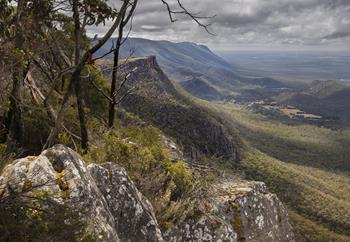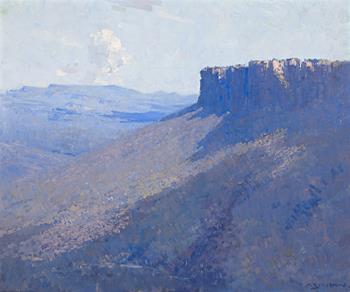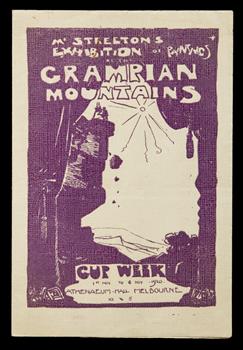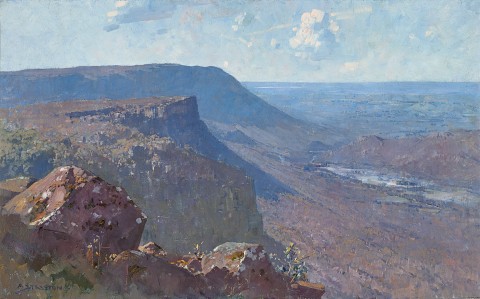BLUE VISTA FROM THE SUNDIAL, 1920
ARTHUR STREETON
oil on canvas
64.0 x 102.5 cm
signed lower left: A STREETON.
Mr. Arthur Norman, Melbourne, acquired directly from the artist by 1935 (label attached verso)
Private collection
Joseph Brown Gallery, Melbourne
Australia and New Zealand Banking Group Collection, acquired from the above
The National Australia Bank Art Collection, acquired from the above in August 1998 (label attached verso)
Mr Streeton's exhibition of paintings of the Grampian Mountains, Athenaeum Hall, Melbourne, 1 – 6 November 1920, cat. 1 (as ‘Blue Vista from the Sundial’)
Recent Australian Landscape by Arthur Streeton, Education Department, Sydney, 21 – 28 November 1921 (as 'Sundial View, Grampians')
Loan Exhibition of works by Arthur Streeton, Art Gallery of New South Wales, Sydney, 20 November 1931 – 20 January 1932
Land of the Golden Fleece – Arthur Streeton in the Western District, Geelong Gallery, Victoria, 20 February – 15 June 2016, cat. 1 (as ‘Blue Vista from the Sundial’)
Streeton – Australia Felix, a Grampians Selection, Hamilton Regional Art Gallery, Victoria, 15 July – 25 September 2016 (as ‘Blue Vista from the Sundial’)
Streeton, Art Gallery of New South Wales, Sydney, 7 November 2020 – 14 February 2021 (as ‘Blue Vista from the Sundial’)
‘Art Notes: Mr. Arthur Streeton Among The Grampians’, The Age, Melbourne, 2 November 1920, p. 8
'Mr Streeton's Pictures', The Argus, Melbourne, 2 November 1920, p. 9 (as ‘Blue Vista from the Sundial’)
'Melbourne Art', The Australasian, Melbourne, 13 November 1920, p. 49 (as ‘Blue Vista from the Sundial’)
'Arthur Streeton: A Farewell Exhibition', The Sydney Morning Herald, Sydney, 22 November 1921, p. 11 (as 'Sundial View, Grampians')
‘Streeton Landscapes. Some Sydney Scenes’, Daily Telegraph, Sydney, 22 November 1921, p. 9 (as 'Sundial View, Grampians')
'The Palette', The Bulletin, Sydney, vol. 52, no. 2703, 2 December 1931, p. 18 (as ‘Blue Vista from the Sundial’)
Streeton, A., The Arthur Streeton Catalogue, Melbourne, 1935, cat. 742 (as 'The Sundial View', dated as 1921)
Edwards, G., Smith, G., and Sullivan L., Land of the Golden Fleece – Arthur Streeton in the Western District, Geelong Gallery, Victoria, 2016, pp. 29 (illus.), 54 (as ‘Blue Vista from the Sundial’)
Tunnicliffe, W., Streeton, Art Gallery of New South Wales and Thames & Hudson, Sydney, 2020, pp. 271 (illus.), 372 (as ‘Blue Vista from the Sundial’)
View up the valley, 1920, oil on canvas, 55.0 x 76.5 cm, in the collection of the Geelong Art Gallery, Victoria
Monta Rosea (or ‘Mount Rosea, Grampians’), 1920, oil on canvas, 63.5 x 76.0 cm, private collection, Sydney
Hall’s Gap (or ‘Hall’s Gap, the Grampians’), 1920, oil on canvas, 64.0 x 78.0 cm, in the collection of the National Gallery of Australia, Canberra
Arthur Streeton is a master of the heroic Australian landscape. Impressive paintings include ‘The purple noon’s transparent might’, 1896, Australia Felix, 1907 and Land of the Golden Fleece, 1926, all in major collections.1 Blue Vista from the Sundial, 1920 has a place among these national icons, confirmed by the enthusiastic reception of Streeton’s contemporaries to this day. Featured in Streeton’s solo exhibition of ‘Grampians Mountains’ paintings at the Athenaeum Hall during the Melbourne Cup Week of 1920, The Age newspaper described them as ‘…more poetical and more romantic than anything that Mr. Streeton has previously done.’ Noting ‘What Streeton has added to his wonderful technique is a warmer note of sentiment’, the reviewer continued, remarking that: ‘…in such beautiful work as the Blue Vista, the View Up the Valley, Hall’s Gap and the Hills of Sassafras, it is the factor that turns the picture into a sensation.’ The show was hailed as ‘…an important event in Australian art. [Marking] the return to his position of pre-eminence of our greatest landscape painter.’2
Blue Vista from the Sundial, 1920 continued to impress in Sydney when shown there the following year. Its presence in Streeton’s November exhibition at the Education Department Gallery was described by The Sydney Morning Herald as ‘serenely majestic in the expression of solitude and of space.’3 And The Daily Telegraph enthused: ‘Perhaps his most complete picture is “Sundial view, Grampians,” a unified impression in which every stage of the composition, from foreground to sky, is carried out with a rare appreciation for aerial perspective. It is a big landscape, painted in a big way.’4 Some years later, in 1931 when the National Art Gallery of New South Wales presented its Loan Exhibition of Works by Arthur Streeton, The Bulletin commented in its own inimitable way:
210722 JOHN GOLLINGS BLUE VISTA FROM SUNDIAL.jpg

'And when, as in “Blue Vista from the Sundial,” you not only get the panorama of vast valleys very nearly as God made it, but feel that if you stretched out your hand you would feel the woolly lichen on the nearest rock, you can’t reasonably ask much more of a painter.’5
In more recent times, Blue Vista from the Sundial, 1920 has returned to centre stage - in Geelong and Sydney. It was catalogue number one in the Geelong Gallery’s 2016 exhibition, Land of the Golden Fleece - Arthur Streeton in the Western District. Neighbouring paintings included Bush Under the Peaks, 1920, Art Gallery of New South Wales, Sydney; Hall’s Gap, 1920, National Gallery of Australia, Canberra; View up the Valley, 1920, Geelong Gallery, Victoria; and Mount Rosea, 1920, which was sold by Deutscher and Hackett in August 2013. When, last year, the Art Gallery of New South Wales presented the major exhibition, Streeton, the accompanying catalogue of the same name featured Blue Vista from the Sundial, 1920 as a double-page colour spread, lavish in detail.6 Illustrating the introduction to the chapter ‘The Big Picture: National Landscapes’, Wayne Tunnicliffe wrote, in part, about the painting:
The blue of the title refers to the atmospheric effect of eucalypt oil particles interacting with light and giving the distinctive blue haze that appears over the Australian bush on sunny days. It is also the colour that becomes most closely associated with Streeton.7
The eye-catching closeness of the foreground rock formations, made up of animated strokes of the brush, enhances identification. In turn, their sharp focus and outline emphasise the precipitous drop, providing an effectively dramatic introduction to the scene, awe-inspiring in imagery as in technique. Rugged escarpments compete with vastness, the ancient land mass metamorphosed by the poetic play of sunlight and shadow, enveloped in the subtlest of blues.
The absence of any figure in Blue Vista from the Sundial, 1920 and other early landscapes of the Grampians give them a distinct individuality. No intermediary is required. Any imagined absence is more than filled by the presence of nature, passionately felt and shared. The close-up foreground provides a breath of intimacy, contrasted with the awe-inspiring panorama and reverence for grandeur. It recalls that admiration of the sublime in nature, which characterised those noble landscapes of Eugene von Guérard and his late colonial contemporaries.
210722 MOUNT ROSEA.jpg

After many years in England, serving in the Great War at the Third London General Hospital, Wandsworth and later as an Australian Official War Artist, Streeton visited Australia with his wife Nora and their son Oliver in 1920. Arriving Melbourne on 2 February, he sought to enhance his Australian reputation and find peace and inspiration in the landscape of his homeland. Success was meteoric, especially for his Grampians paintings which he considered, as he later wrote to Sydney Ure Smith, ‘…the best that I painted when last in Australia’.8 He first visited the Grampians in September 1920, staying at Harold Armytage’s homestead near Dunkeld, at the southern end of the scenic mountain chain. Peace, freedom and the sparkle of early spring fills canvas after canvas, especially Blue Vista from the Sundial, 1920, the largest work in the Melbourne exhibition in November. Streeton, himself, reflected:
When painting among the Grampians Hills, I found that my best subjects were visible from the crest of the Peaks: it took a hour’s steady climbing laden with canvas colours easel palette lunch & billy of water … pausing halfway for a breath & looking up at the dizzy heights … But once perched upon the Sundial Peak, above the world, the reward is evident in a vast expanse of pale blue over myriad gums rising to Mount Rosea, or over Boronia Peak to Stawell 20 miles to the East.9
Filled with the promise of spring’s renewal, Blue Vista from the Sundial, 1920 is a bravura celebration of the Australian landscape – an image of national optimism. His love affair with the countryside continued when, in 1921, Streeton bought five acres of land at Olinda in the Dandenong Ranges near Melbourne, where he would return a few years later to build ‘Longacres’, to live and to paint.
210722 Mr Streeton's exhibition of paintings of the Grampian Mountains.jpg

1. ‘The purple noon’s transparent might’, 1896 is in the collection of the National Gallery of Victoria, Melbourne; Australia Felix, 1907 in the Art Gallery of South Australia, Adelaide; and Land of the Golden Fleece, 1926, in the National Gallery of Australia, Canberra. Streeton painted three versions of Land of the Golden Fleece, 1926. The other two are in the collections of the National Gallery of Victoria, Melbourne and, the largest, in the Australian Club, Sydney.
2. ‘Art Notes: Mr. Arthur Streeton Among The Grampians’, The Age, 2 November 1920, p. 8
3. ‘Arthur Streeton. A Farewell Exhibition’, Sydney Morning Herald, Sydney, 22 November 1921, p. 11
4. ‘Streeton Landscapes’, Daily Telegraph, Sydney, 22 November 1921, p. 9
5. ‘The Palette’, The Bulletin, Sydney, 2 December 1931, vol. 52, no. 2703, p. 18
6. Tunnicliffe, W. (ed.), Streeton, Art Gallery of New South Wales, Sydney and Thames & Hudson Australia, Melbourne, 2020, pp. 252 – 53
7. Ibid., p. 257
8. Streeton letter to Sydney Ure Smith, 16 June 1922, Sydney Ure Smith Papers, MS 31/3, Mitchell Library, SLNSW, quoted in Mary Eagle, The Oil Paintings of Arthur Streeton in the National Gallery of Australia, Canberra, 1994, p. 159
9. Arthur Streeton, Notes for Memoirs, Streeton Family papers, quoted in Eagle, ibid., p. 159
DAVID THOMAS
